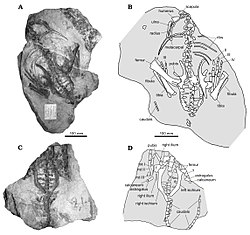Stenopelix
|
Stenopelix Temporal range: Early Cretaceous, 127 Ma |
|
|---|---|
 |
|
| Slabs of the holotype and interpretive drawings | |
| Scientific classification | |
| Kingdom: | Animalia |
| Phylum: | Chordata |
| Class: | Reptilia |
| Clade: | Dinosauria |
| Order: | †Ornithischia |
| Suborder: | †Ceratopsia |
| Genus: |
†Stenopelix Meyer, 1857 |
| Species: | †S. valdensis |
| Binomial name | |
|
Stenopelix valdensis Meyer, 1857 |
|
Stenopelix (meaning "narrow pelvis") is a genus of small ornithischian dinosaur from the Early Cretaceous of Germany. It was perhaps a basal ceratopsian from the Barremian Stage of the Cretaceous period, sometime between 130 and 125 million years ago. The genus is based on a partial skeleton lacking the skull, and its classification is based on characteristics of the hips.
In 1855, in a sandstone quarry near Bückeburg on the Harrl heights, a fossil was found of a small dinosaur. Most of its bones were in a poor condition and removed on preparation, leaving two sets of hollow impressions on the plate and counterplate. The two plates do not overlap completely. The hollows, serving as a natural mold, have since been used to produce several casts in gypsum and latex to facilitate the study of the specimen. It was originally part of the collection of Max Ballerstedt preserved in the Bückeburg Gymnsasium Adolfinum but was in 1976 moved to the Georg-August-Universität Göttingen were it now resides in the collection of the Geowissenschaftliches Zentrum der Universität Göttingen.
In 1857, based on this fossil, Christian Erich Hermann von Meyer named the type species Stenopelix valdensis. The generic name is derived from Greek stenos, "narrow", and pelyx, "pelvis". The specific name refers to the Wealden Formation. The holotype, GZG 741/2 (earlier GPI 741-1, 2), found in the Obernkirchen Sandstein Formation, consists of the impressions of an almost complete skeleton, lacking the skull and the neck.
...
Wikipedia
